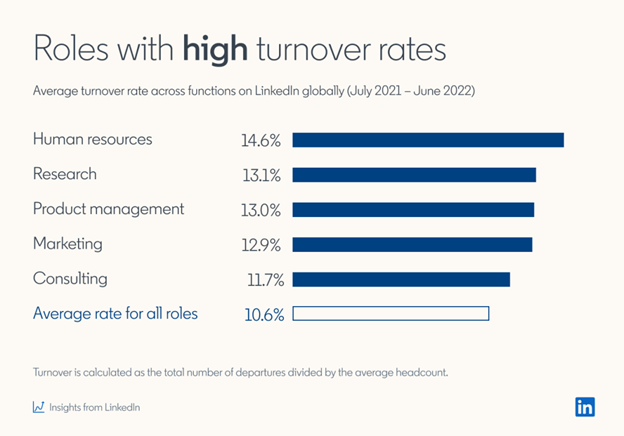Human resources professionals are no strangers to the importance of employee retention. As a critical element of their performance, hiring and retaining top talent at a company, which includes reducing turnover, is part of their day-to-day responsibilities. This is why the current turnover rate for the profession is so shocking. According to LinkedIn, human resources leads all professions in turnover for the last 12 months, topping the average for all roles by four percentage points. For the purpose of this analysis, turnover is based on professionals updating their current employer on their LinkedIn profile.

It may be easy to build a narrative to explain why human resources leads in turnover. One might argue that the stress of COVID-19 disproportionately impacted those professionals in charge of managing a radically new work environment and tightening labor market. This would ignore the fact that the profession has consistently had some of the highest turnover, ranking among the top three functions over the past three years. Another argument that could explain the consistently high turnover is that human resource professionals have a front row seat to how employers treat their employees, making them quicker at identifying and stepping away from dysfunctional cultures.
Human Resources Burnout
The narrative that resonates most is that human resources is a hard profession with a lot of demands and has always been this way. According to a workplace communication app, Workvivo, 98% of human resource professionals felt burned out at work in the last six months and nearly four in five are open to leaving their jobs. This suggests the 15% turnover may be anchored by the friction of switching jobs, not by the remaining professionals being satisfied with their work.
With so many competing priorities (e.g., hire the best talent with a limited budget, deliver feedback, etc.) and insufficient resources, human resource professionals are easily susceptible to burnout. To further exacerbate the problem, the critical roles these individuals fill within an organization often go unappreciated, unlike the burnout a software developer may experience when finally releasing a new feature. Although appreciation for your work does not eliminate stress, it certainly helps build resilience to cope with it.
Employer Response
If employers truly care about retaining their employees, they need to start thinking about the retention of those individuals who are responsible for reducing turnover for the entire organization. Like all employees, these professionals stand to benefit from resources that will help improve their ability to reduce and manage workplace stress. Whether it is access to mental health benefits or policies that help create clear lines between work and personal time, companies can help reduce human resources turnover and dissatisfaction by lowering burnout. Fortunately, these actions will also benefit other groups and lower turnover across an organization.
Companies must also make sure to recognize the hard problems human resources address. Creating culture, supporting a safe work environment, and managing competing interests are not easy, and many of the responsibilities of human resources are not as visible as other departments, such as sales and product development. Leadership should highlight the successes of these professionals publicly to show their appreciation and encourage others in the organization to do the same.












